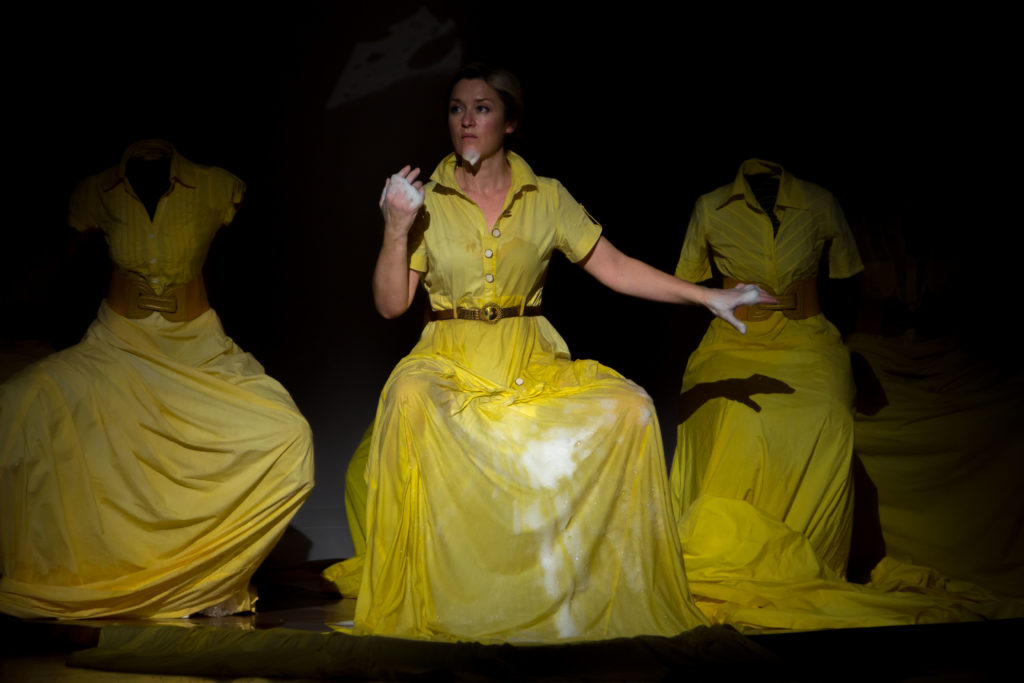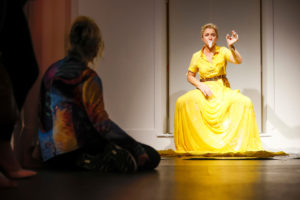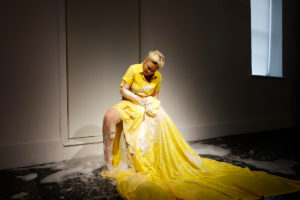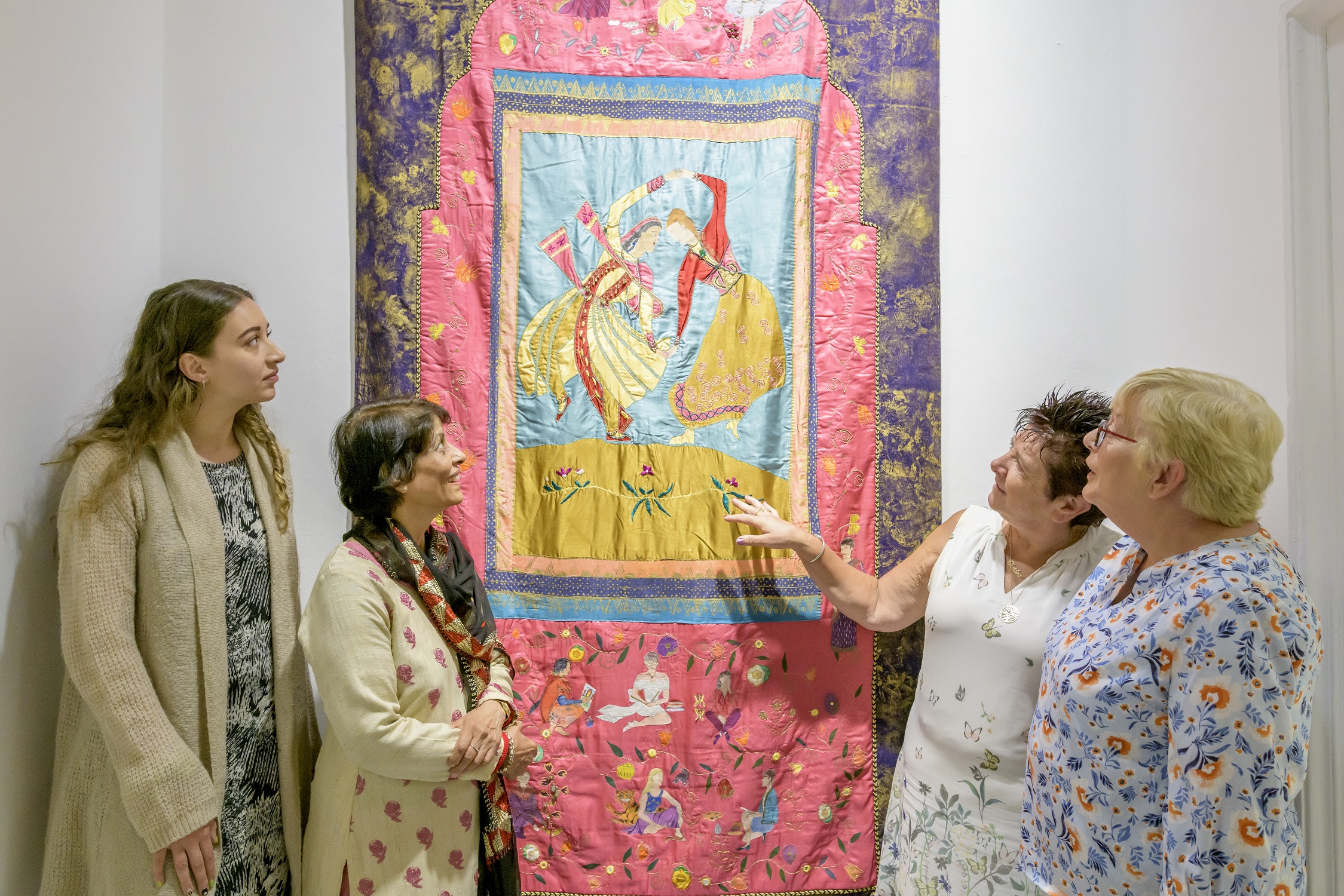Witnessing ‘Yellow’ by Paola Catizone

In this magazine article visual artist Paola Catizone discusses ‘Yellow’ by Amanda Coogan, performed in 2021 as part of the IMMA exhibition The Narrow Gate of the Here-and-Now; Queer Embodiment.
Catizone is an arts educator (at IMMA) and a yoga and movement facilitator. Originally from Italy, Paola has lived and worked in Ireland for many years. She holds a BA and MFA from the National College of Art & Design, Dublin. Paola combines the immediacy of drawing and the directness of Performance Art in her work. She engages in interdisciplinary collaborations, working with choreographers, musicians and video artists.
……………………………………………………………………………………………………………………………………………………………………………………………………….
In September 2021, Seán Kissane, Curator of Exhibitions at IMMA, asked me to assist artist Amanda Coogan in two performances of her seminal work, Yellow, recently acquired by the IMMA Collection. Yellow was on display as part of Queer Embodiment, the first chapter of the museum-wide exhibition, The Narrow Gate of the Here and Now.
Coogan is a durational performance artist who studied under Marina Abramović, a Serbian conceptual and performance artist whose work explores the relationship between performer and audience, the limits of the body, and the possibilities of the mind. Abramović, who is often referred to as the grandmother of Performance Art, developed the Abramović method for performance art training, which prepares participants to both perform and observe long durational work.
As an internationally acclaimed Irish artist, Coogan’s work often refers to challenging periods in Irish history, which she addresses from a contemporary feminist perspective. Growing up in a family with two deaf parents, the artist learned sign language early in life. Amanda’s father spent some of his own childhood years in one of the homes for deaf boys, at a time when a disproportionate number of Irish people were interned within institutions, whether Industrial Homes, Magdalene Laundries, prisons, or psychiatric hospitals. Coogan’s endurance test is a tribute to all of these innocent prisoners, in particular to the children in the Deaf Schools and the women in the Magdalene Laundries, the last of which closed its doors as recently as 1996.
We meet on Zoom. Coogan talks about Beckett’s Not I (1972), and of the mysterious figure of the ‘The Auditor’. She imagines my role in Yellow as a sort of ‘auditor’, and our interaction during the performance as a ‘duet’. My role, in fact, will be practical. As Yellow involves soapy water, I will use a mop to dry out any spillage. I will be ‘in role’ wearing a white medical overcoat. I will play Shubert’s 4th Sonata in A flat on an MP3 player at regular intervals throughout the performance, which will take place over seven uninterrupted hours.

3 October 2021, 10 am – 5:30 pm:
In the gallery, props and materials are in place. A large white bin has been filled with water and several containers of Matey Bubble Bath stand beside it. A platform acts as temporary stage between two long mauve curtains, framed by two artworks. Behind us is Vivienne Dick’s video, Liberty’s Booty (1980), featuring candid shots taken in a New York brothel, interspersed with imagery of the pope’s visit to Ireland. There is a connection between this work and Yellow, with reference to female sexuality and to the infamous Magdalene Laundries, where single mothers and ‘fallen women’ were interned. In the alcove facing Yellow, is Alice Maher’s Familiar 1 (1994). A large red colour field canvas with an image of a little girl is presented alongside a skein of unbleached flax, resembling human hair, which hangs from wall to floor, reminding me of Mary Magdalene. The three works seem to be engaged in conversation, supporting each other.
It’s 11 am and the artist is sitting on the bin, her enormous skirt pouring down from her waist, forming a large, yellow rectangle on the floor. Her legs are open wide, and a stream of liquid soap runs downwards from her lap. Her posture echoes depictions of Renaissance Madonna and Irish Sheela Na Gigs, unapologetically, unashamedly exposed.
Covid-19 lockdowns are recent, and the museum is quiet. In the lonely, cold gallery, sitting on her tall bucket, the performer begins her rhythmic task. It doesn’t take long for her knuckles to become red, and for the washing gestures to begin to look like labour. She plunges both arms deep into the cold water between her legs, searching, then pausing, as if about to pull a newly birthed infant from the depths. She shapes the soaked fabric into a vertical, phallic form rising from her lap, then suddenly stands, throwing the length of the huge skirt onto the floor, over and over, evoking the repetitive nature of female domestic labour.
The relentless circular scrubbing of cloth between two hands, the wiping away of froth, the seven hours stretching ahead, already make the task appear impossible. Fabric, water, foam, body, space, and time are the sculptural and performative materials of this epic work. In her writings, Coogan tells us that durational performance art relies on four pillars:
- Body (of the performer)
- Place (in this instance, the East Wing Gallery at IMMA)
- Time (still stretching ahead of us and offering unknown possibilities)
- Audience (scarce on this occasion)
At various times during the day, I am alone in the gallery with the artist. As her concentration deepens through repetition, she enters a state of ‘flow’. The attention and presence of an audience support the artist in sustaining concentration. In return, observers partake of some of the artist’s experience of endurance. People gradually enter the space in pairs and in small groups. An older woman stands, leaning on the wall near the performer, and remains for about two hours.
I play Schubert when Coogan seems tired. The melancholy piano notes elevate her energy. The frantic labouring stops, and she rises from the depths into a trance-like, radiant state, her arms raised gracefully, her body light, eyes gazing into the distance. Stillness pervades the space; viewers seem to hold their breath. The folds of the dress are also still now, like the drapery of classical sculpture, the white bucket resembling a plinth. Motion resumes, always returning to the task of washing.
Coogan draws large soapsuds from her dress and feeds them into her open mouth, later spitting them out to form a white beard from mouth to chin. In her book, Sexual Personae (Yale University Press, 1990), Camille Paglia analyses western art through the lens of classical mythology. She assesses artistic representations of the eyes as reflecting the Apollonian values of logic, order, and mental clarity. The mouth carries chthonic qualities of unconsciousness, depth, and the messiness of the body. What would Paglia make of Coogan’s foaming mouth – of the biting, dribbling, and spitting? The image is grotesque and unsettling. Is this a beautiful, strange, bearded lady, or a large white tongue, the inside coming out in a frothy release? “She’s a bitch, that one”, Coogan says later.

At times, the performer bites the fabric, lifts it, and moves it around while scrubbing, using mouth and teeth as a third hand. She stands and the triangle of yellow fabric hangs from her mouth to the floor. Coogan’s 2015 work, I’ll sing you a song from around the town, featured monumental soft sculptures made of fabric. Textile art has traditionally been the province of women. In I’ll sing you a song…, the heroic, permanent gesture of classical statues was re-imagined through a material that is both impermanent and pliable, impinging less on a world afflicted by too many manmade objects. Watching Yellow is also a sculptural experience, during which forms last only seconds, before being transformed.
When she immerses her arms in water again up to her shoulders, a rhythmic, fast, eager movement that we cannot see begins. She looks over her shoulder like a crouching animal slaying its prey; she also reminds me of a witch figure from Goya’s print series, The Disasters of War (1810-20). Now she raises both legs and balances her body weight on the rim of the bucket. I remember Coogan being asked during a lecture how she prepares for her performances: “I do my Yoga, I rest” was the answer.
After the first three hours, everything changes. Vulnerability is exposed and pathos becomes visible. The performance becomes a sacrificial act. It becomes clear why this is not a ‘duet’; I am sitting in relative comfort, while she’s endlessly labouring. Later on she comments: “At some point it’s not even performance anymore”. Actions emerge as ways of managing strain. Durational performance art truly is “Making, not faking”, in the words of cultural anthropologist, Victor Turner. This distinction between the performing arts and performance art is that during the latter, events are really happening in unrehearsed ways in front of our eyes, and the exhaustion is real.
Suddenly standing up and throwing the heavy wet fabric forward, the performer loses her balance and falls. She lands on her hands and knees and immediately bounces backwards, like in the rewinding of a movie scene. I recognise pandiculation, an animal movement that allows four-legged mammals to pounce and retreat effectively.
Towards evening, the gallery becomes busier, and the performer’s body is driven by something other than physical strength. Now, as she continues to scrub, she raises her eyes, and her face is transfigured; in my tiredness I see the face of one of the Magdalene girls. Later, she tells me, “It couldn’t happen without the time factor”. The sustained concentration and physical exhaustion engender visions. The tenderness and strength of the female body has been revealed in its universality.
Physical empathy is central to the notion of ‘Direct Body to Body Transmission’. In the Abramović Method, viewers are in direct connection with the performer, by virtue of inhabiting the same space and physical field of experience.
Towards evening, a circle of people surrounds us. A group of older women appear moved by the work, and give me a nod of acknowledgement, and an empathetic look through tearful eyes. Some ask how many hours Yellow had been going on today and are awed by the reply. The last one to leave holds her hand on her heart while saying, “This is one of the best things I’ve ever seen”.

7 May 2022, 12 noon – 5:30 pm:
Covid restrictions have been lifted. As soon as the performance begins, visitors come in. Coogan appears to make eye contact with the audience, smiling sometimes. “I only see shadows” she says later.
An atmosphere of empathy is palpable, revealing people’s natural tendency to want to support someone engaged in a massive effort. Upholding her. Sharing the weight. Some viewers stay for several hours, perhaps wanting to share in the experience of ‘durationality’. Others are possibly engaging in a collective act of exorcism, healing memories of institutional abuse through this cathartic work.
Slow movement and sculptural moments of stillness unfold, reminiscent of Coogan’s performative photographic prints. A distinguishing feature are the artist’s clothes in primary colours. I ask her about the significance of colour and she shrugs; she just likes it, she says. However, Coogan’s early training in painting may account for the prominence of colour in her work.
Now she twists the fabric into a long, snake-like shape, which she wraps over her shoulder, mirroring the gesture seen in a large oil painting on canvas hanging on the opposite side of the corridor wall, in room 3: Hughie O’Donoghue’s Laocoon (2003). The original inspiration for the painting, the ancient marble sculpture The Laocoon Group, is the prototypical icon of human agony in Western art. This is a suffering that offers no redemption. The notion of effort in pursuit of gain is disturbed in Yellow; the artist’s herculean task doesn’t have a practical outcome. Later, I ask: “Do you ever feel you can’t continue?” The succinct, definite answer: “Yes!”.
She mentions flow: “Falling off … having to climb back up”. Flow is a state of continuous absorption in a task, as described by psychologist Mihaly Csikszentmihalyi in his book Flow: The Psychology of Optimal Experience (Harper & Row, 1990) and often quoted in Coogan’s talks. A movement emerges with a lateral flinging of the long skirt, creating a rhythm. The heavy, wet fabric slaps the walls and splashes viewers with water and bubbles. Eventually the garment tears under the force of the action. Coogan later tells me that the movement helps her warmup when she’s cold.
At intervals we hear the voiceover of Dick’s Liberty’s Booty: “So, I’m a whore, he swindles the banks, who gives a fuck?! I mean, he doesn’t go to jail for what he does…” The gallery’s video and sound installations are now being switched off. The scrubbing, panting, and grunting becomes audible. Someone asks: “Does the lady speak?”, “Not during the performance” I reply, and I am reminded of Coogan’s childhood in a relatively silent household. I play Schubert again; it was recorded during a live performance, and it includes watery sounds and concludes with a recorded applause. It’s 5:25 pm. The audience stand up and we applaud.
……………………………………………………………….
Interested in learning more about Performance Art? Visit our What Is_? series which provides an overview of the term and how this practice has evolved over time.
Categories
Further Reading
What is Performance Art?
IMMA invited Amanda Coogan, artist and researcher, to write an essay on Performance Art entitled What is Performance Art?, which makes reference to artists and artworks in IMMA’s Collection as a means of des...
Up Next
'Dance of Life' - West Tallaght Women's Textile Collective
Thu Dec 15th, 2022